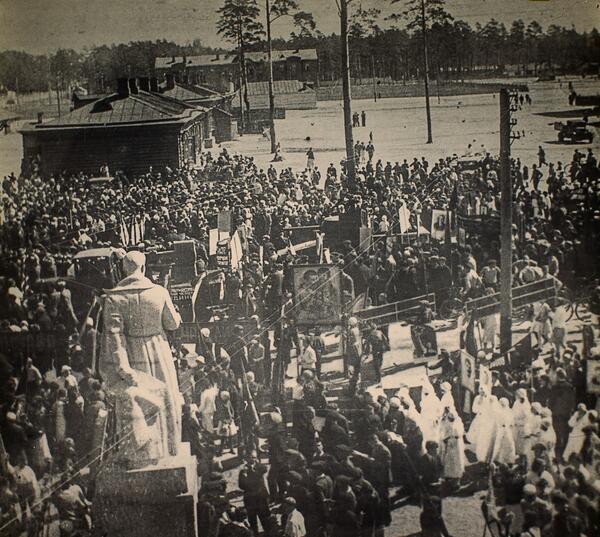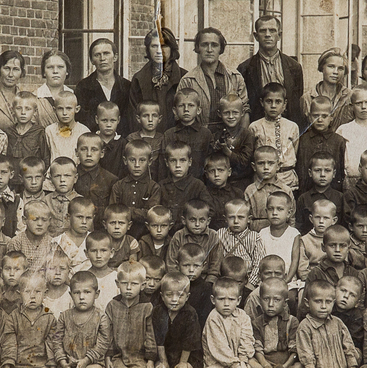This photograph of the May 1st Parade was taken in the Krasny Boyevik settlement (nowadays known as the town of Kotovsk) by a local citizen Nikolay Kozadayev in 1939.
Nikolay Kozadayev was born in a workers’ settlement at the Tambov Gunpowder Factory. He graduated from the seven-year school No. 1 and worked at an art workshop in Tambov. The photograph from the museum’s collection was taken by Kozadayev after he had been enlisted by the Kotovsk Military Commissariat and before he left for the army.
The center of the photograph shows a 13-meter-high statue of Joseph Stalin. Such large Stalin monuments were usually placed on the central square of a city or a town. They constituted an integral part of the Soviet monumental art in the 1930s — 1950s.
Kozadayev took a picture of participants of the May 1st Parade. Among them are factory workers, nurses, members of various groups as well as a cycling club. They carry banners, posters with slogans, and portraits of Communist leaders. There is a truck in the center of the square — back then such vehicles often served as the platform for public speakers.
The background of the photograph shows six log houses constructed for the engineers of the Tambov Gunpowder Factory. Such houses were mainly built in settlements with forest areas, such as the Tambov factory’s settlement.
Behind the log houses, there is a building in the style of classicized eclecticism.
This stone 2-story building was constructed for the factory’s needs in 1917. It served as a fire station and was used to store fire-fighting equipment. In December 1917, the building was named ‘Svoboda’ (Freedom). It was used to station the first Soviet of Workers’ and Soldiers’ Deputies, and later housed various factory organizations and unions, including a theatre, a lecture room, a general meeting room, an artists’ room, a lobby, two classrooms, and a teachers’ room. The workers’ settlement at the Tambov Gunpowder Factory was granted town status and was renamed Kotovsk in 1940 by a decree of the Presidium of the Supreme Soviet of the USSR.
Nikolay Kozadayev was born in a workers’ settlement at the Tambov Gunpowder Factory. He graduated from the seven-year school No. 1 and worked at an art workshop in Tambov. The photograph from the museum’s collection was taken by Kozadayev after he had been enlisted by the Kotovsk Military Commissariat and before he left for the army.
The center of the photograph shows a 13-meter-high statue of Joseph Stalin. Such large Stalin monuments were usually placed on the central square of a city or a town. They constituted an integral part of the Soviet monumental art in the 1930s — 1950s.
Kozadayev took a picture of participants of the May 1st Parade. Among them are factory workers, nurses, members of various groups as well as a cycling club. They carry banners, posters with slogans, and portraits of Communist leaders. There is a truck in the center of the square — back then such vehicles often served as the platform for public speakers.
The background of the photograph shows six log houses constructed for the engineers of the Tambov Gunpowder Factory. Such houses were mainly built in settlements with forest areas, such as the Tambov factory’s settlement.
Behind the log houses, there is a building in the style of classicized eclecticism.
Classicized eclecticism is an architectural style of the early 20th century. It combined various decoration elements. One façade could feature such elements as classical columns, porticos, and cornices and also modern details such as industrial murals or attics — decorative corner walls.
This stone 2-story building was constructed for the factory’s needs in 1917. It served as a fire station and was used to store fire-fighting equipment. In December 1917, the building was named ‘Svoboda’ (Freedom). It was used to station the first Soviet of Workers’ and Soldiers’ Deputies, and later housed various factory organizations and unions, including a theatre, a lecture room, a general meeting room, an artists’ room, a lobby, two classrooms, and a teachers’ room. The workers’ settlement at the Tambov Gunpowder Factory was granted town status and was renamed Kotovsk in 1940 by a decree of the Presidium of the Supreme Soviet of the USSR.



